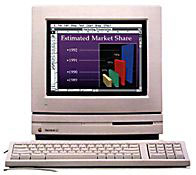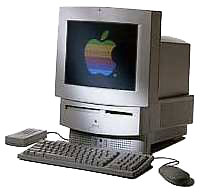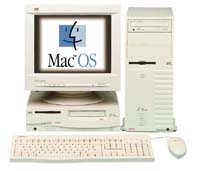The iMac is a wonderful desktop computer, but Apple has discovered
that it's hard to compete. Where Apple once dominated education - the
top platform, not just the top brand - they've now fallen to second
place.
That said, we must remember that Dell has done such a good job
overtaking Apple in the education market that they've just announced
layoffs for 4,000 employees.
We already looked at the eMac, a less costly
iMac modified specifically for the education market. Of course, we're
still looking at an estimated $699 price tag.
Apple can do better by thinking a bit less differently on the low
end.
History Lessons
The LC
A little over ten years ago, Apple attacked the education market and
the installed base of Apple II computers  with the
Macintosh LC, a compact and
relatively inexpensive color computer that used an external monitor and
accepted an emulator card for the old Apple II software. Rumors are
that the LC series was Apple's biggest success until the iMac came out
in 1998.
with the
Macintosh LC, a compact and
relatively inexpensive color computer that used an external monitor and
accepted an emulator card for the old Apple II software. Rumors are
that the LC series was Apple's biggest success until the iMac came out
in 1998.
Why was it so successful? First, because it didn't force schools to
abandon their investment in Apple II software. Second, because it was
pretty darned affordable. And third, because Apple went out of their
way to sell them to educators, not just school systems. There was even
a dual-floppy LC for those who didn't think they needed a hard drive,
already hard a hard drive, or simply couldn't afford a hard drive.
The LC 520
Apple introduced the LC 520 in
1993, essentially an LC III with a built-in monitor and a CD-ROM drive.
It was  perfect for schools, since it only needed
one power cord, could be networked easily, and still accepted the Apple
IIe card for all that old software.
perfect for schools, since it only needed
one power cord, could be networked easily, and still accepted the Apple
IIe card for all that old software.
This design evolved with faster processors, then a new case design,
and eventually gave birth to the iMac.
Oops, I Blew It Again
Nice as it was to have Apple focus on the education market, some of
the worst Road Apples (Macs that
were less than they should have been) were created for that market.
For instance, the LC put an obsolete 16 MHz 32-bit processor on a
16-bit data bus and artificially limited memory expansion to 10 MB. The
LC II, Classic II, and Color Classic used the same design with a
slightly different processor. All these computers were decent
performers, but they should have been better.
Skipping ahead to 1995, we come to the Performa 5200 and 6200. These two models and their
offspring form the x200 series, which we consider the most compromised
hardware designs in Mac history. To fully understand the scope of these
mistakes, read the x200 Road Apple
report followed by the x200 Technical
Report, but in a nutshell the design was full of bottlenecks that
seriously compromised performance.
For the record, these problems were eliminated in the next
generation of models with a new motherboard design. The 6360 and 5400 did not suffer from the
bizarre architecture of their predecessors.
With the 1999 introduction of the Blue & White Power Mac G3,
Apple eliminated traditional desktop Macs from their product line. From
that point forward, all they have offered are iMacs and tower designs.
(Although the Cube has
a small footprint, the fact that you can't put a monitor on top of it
makes it more akin to towers than desktops.) It seems they have
forgotten the great success of the LCs and Performas with separate
monitors.
Economic Realities
It's cheaper to buy a new computer and keep your old monitor than it
is to buy the combination. With the iMac, schools have no choice about
the monitor; it's part of the computer. There are a lot of benefits to
that, but there's also some unnecessary cost.
I believe Apple needs to introduce a new desktop computer - one of
those nice compact designs that sits under the  monitor, has one or two expansion slots, and sells for
a lot less than the all-in-one iMac.
monitor, has one or two expansion slots, and sells for
a lot less than the all-in-one iMac.
My model for this is the SuperMac
C500, the computer beneath the monitor in the photo to the right.
The C500 was about 4" tall and packed a hard drive, CD-ROM, floppy
drive (remember those?), power supply, and two PCI slots into very
little space.
If Apple were to use the C500 for inspiration and build a new
desktop computer for today, I think it would find a ready market. To
keep costs to a minimum, it should share as many components with the
iMac and Power Mac G4 as possible. I'm guessing specs would look like
this:
- 400 or 500 MHz PowerPC 750CX, as used in the iMac
- 64 or 128 MB RAM on the motherboard
- one DIMM slot for adding up to 512 MB RAM
- 10 GB hard drive
- same ATI RAGE Ultra 128 used in the iMac
- two USB ports
- two FireWire ports
- 10/100 ethernet
- AirPort slot
- slot for optional 56k modem
- two PCI slots
As I've already proposed for the eMac and
eBook, CD-ROM, DVD, etc. would be strictly
optional. The cMac (for compact and cost-effective) could work with the
same external drives as the eMac, but also have an internal drive bay
for those who want to have an internal CD, DVD, etc.
As with the new iBook,
Apple could offer a fairly stripped model with minimal RAM and no
CD-ROM, making models with more base RAM and various media drives
available at higher prices. I can't see any reason Apple wouldn't be
able to sell a basic cMac to schools for under US$500. Even with an
inexpensive 17" monitor, it could cost less than the proposed eMac, let
alone today's entry-level iMac.
Why So Cheap?
You might wonder why we're aiming for such a low price on the base
cMac. It's very simple: Macs have always been perceived as overpriced.
Always. By showing schools that Apple can produce an inexpensive,
well-built computer, we attack that perception head-on.
Another huge factor, one we faced when fighting for the Mac here in
Grand Rapids (MI), is that school systems aren't limited to Dell,
Gateway, Compaq, and the other national brands. In our case, we were
going up not only against the Windows mindset, but also against Wintel
clones cobbled together in a nearby city. A small local clone maker
could promise the moon, sell cheap, build cheaper, close up shop, and
pocket their profits after fulfilling their half-million dollar or so
contract.
Instead of no-name clones or bargain basement brand name PCs,
schools could buy genuine Apple, a brand they may have been using since
the 1970s. By making the base unit so cost effective, schools could
afford to upgrade RAM, buy Virtual PC (for those who buy into
"the ridiculous notion that kids will fail later on in life if they
don't know how to operate a Windows PC."), run ethernet cabling or
install AirPort hubs, etc.
If school systems want to ignore quality and play price games, Apple
has the ability to offer quality and compete on price - if they want
to.
Selling the cMac
We've created a very cost-competitive computer for education, but we
need to sell it to schools. That's often an uphill battle, and I see no
need to rehash the Mac vs. Windows debate (John Droz has done a great
job with Should Our Schools (or Anybody
Else) Have Macs or PCs?).
Instead, we need to address the peculiarities of the cMac vs. Wintel
desktops.
No Floppy
Floppy drives are no longer considered essential in the Windows
world; they are becoming an option on more models every month - a trend
Apple began.
Floppies make it easy to transport files between home and school,
which may mean unwanted or illegal transfer of software. By eliminating
floppies, schools reduce the likelihood of software license violations
and unwanted software on school property.
Before the Internet, floppies were the primary means for
distributing viruses. By making the floppy an external option, it
becomes that much more difficult to move a disk- or file-based virus
between computers.
No CD-ROM (base version)
By not including a CD-ROM drive in the cMac, Apple would make it
that much harder for students to install unwanted/unauthorized software
on school computers. They wouldn't be able to rip MP3s from the
favorite CDs on the school cMac. They wouldn't be able to bring in
games from home.
By giving buyers the option of internal or external CD-ROM, DVD,
CD-RW, etc., the school can decide which technologies are available and
where. A classroom might have 2-3 external CD-ROM drives for installing
software and a Combo Drive in the teacher's computer so he/she can
archive files and run DVDs.
If anything, removing floppies and CD-ROM drives from school
computers is a benefit: it protects the system setup, prevents
unauthorized software transfers, and reduces the cost of the computer
itself.
Mac Advantages
Perhaps the biggest plus for any current Macintosh - AirPort. By
installing one or more base stations, any recent Mac accepts a $99
AirPort card for wireless networking. No need to pull wires. No need to
put the computer where there's an ethernet port. This could save
thousands upon thousands of dollars in wiring costs.
Nearly Perfect
The cMac would be nearly perfect as an education computer, since it
would allow them to use existing monitors and choose the appropriate
display size when buying new displays. The cMac is also small enough,
powerful enough, and inexpensive enough to set up as a headless
server.
On top of that, it would be very appealing to teachers for home use,
since they could buy the entry-level cMac and upgrade as finances
allow.

 with the
with the
 perfect for schools, since it only needed
one power cord, could be networked easily, and still accepted the Apple
IIe card for all that old software.
perfect for schools, since it only needed
one power cord, could be networked easily, and still accepted the Apple
IIe card for all that old software. monitor, has one or two expansion slots, and sells for
a lot less than the all-in-one iMac.
monitor, has one or two expansion slots, and sells for
a lot less than the all-in-one iMac.
